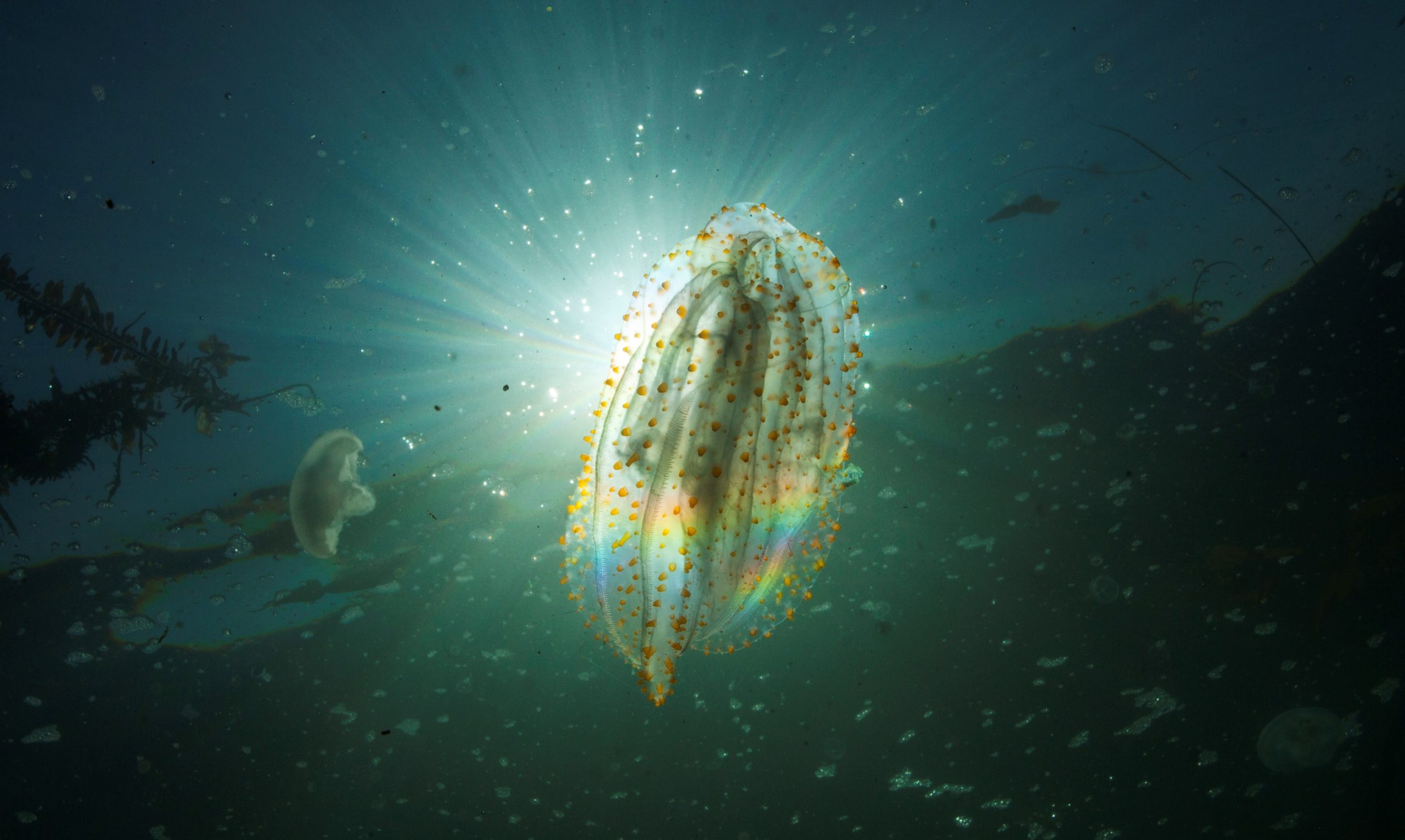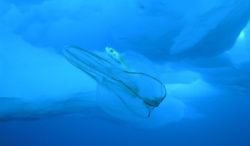
Sea Wonder: Comb Jelly

A lobate comb jelly in Monterey Bay National Marine Sanctuary. Photo: Chad King/NOAA
Comb jellies are transparent, gelatinous invertebrates that drift through the waters of our global ocean. There are between 100 and 150 known species of comb jellies, the best known of which are found close to shore. They are related to jellyfish, but not as closely as they might seem.
Description
Comb jellies are colorful, simple invertebrates that are part of the family Ctenophora. Their combs are giant fused cilia cells that allow the animals to swim, and they also scatter light like a prism and present a rainbow of colors. They have two large, trailing tentacles that branch out to create the appearance of a net-like structure of many tentacles. These organs serve as sticky fishing lines, which they use to trap and move prey to their bodies.
These animals have two major cell layers, the external epidermis and internal gastrodermis; in between these cell layers is the mesoderm that is what gives the animals their gelatinous appearance. Many species are bioluminescent, meaning they can use proteins in their bodies to create an ethereal blue or green glow in response to stimuli like touch. Not only is this a beautiful display, but it also serves as a biological defense mechanism.
Comb jellies have nervous system cells in their epidermal layer that allows them to sense environmental stimuli like light or chemicals. In the gastrodermis is the animal’s gut where both food and reproductive cells enter the body. The mesoderm is mostly water and acts as a soft skeleton as it contains muscle cells, proteins, and nerve cells. Each species varies in length, but the average size of a comb jelly is about four inches long. Since they are mostly made of water, they don’t weigh very much at all.
There are three groups of comb jellies, each of which is known for a distinct appearance:
Cydippids, known for rounded bodies and branched tentacles;
Lobates, known for two flattened lobes and short tentacles; and,
Beroids, known to be sac-shaped and lacking tentacles.
Diet & Habitat
Comb jellies are carnivorous and opportunistic, feeding on whatever passes them by. Using sticky cells (colloblasts) that are lined on their tentacles, they can capture prey and then move the victim to the main body for digestion. Their diets vary based on where in the ocean they live, but it is most often a diet of zooplankton, larvae, and sometimes small fish or other organisms. Natural predators of comb jellies include sea turtles, fishes, marine mammals, and even other comb jellies.
Comb jellies use different feeding strategies based on the species and its habitat, but most are known as passive feeders. Recently, scientists discovered that comb jellies remove waste not through their mouths like similar invertebrate species, but instead release the indigestible byproducts of waste into the water through pores at the end of their bodies.
Life History
We find comb jellies in all areas of the world’s ocean, and especially along the eastern coasts of the Americas. Most species prefer warmer temperate, tropical, or subtropical waters and live near the ocean’s surface.
Comb jellies are simple organisms and have an equally simple lifecycle. Most individuals are hermaphroditic, able to produce both eggs and sperm into the water column to fuse with other gametes to promote genetic diversity. These animals can also reproduce asexually by cloning themselves through a process called budding. Few larval comb jellies survive into adulthood as they are eaten by larger organisms. Reproduction can occur all year long, but generally happens at night and at times when food is plentiful. In times of food shortages, comb jellies shrink their body size to conserve energy and pause reproduction, growing and resuming reproduction again when food is more available.
Threats & Conservation
Comb jellies tend to be abundant when ocean conditions are unfavorable for other species; when their populations are out of balance, we can infer that the quality of the ocean is diminishing. Comb jellies are more successful than other species because of their tolerance to wide ranges of salinity, temperature, and other environmental factors. Threats to comb jellies include chemical pollution, ocean acidification, and climate change.

An arctic comb jelly, a type of cydippid comb jelly. Photo: The Hidden Ocean, Arctic 2005 Exploration; NOAA/OAR/OER
